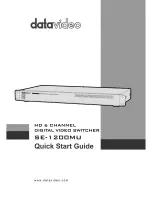
Chapter 3 Hardware Panels
GS1350 Series User’s Guide
34
• Duplex: Auto
• Flow control: Off
• Link Aggregation: Disabled
3.1.1.2 Auto-crossover
All ports are auto-crossover, that is auto-MDIX ports (Media Dependent Interface Crossover), so you may
use either a straight-through Ethernet cable or crossover Ethernet cable for all Gigabit port connections.
Auto-crossover ports automatically sense whether they need to function as crossover or straight ports, so
crossover cables can connect both computers and switches or hubs.
3.1.2 PoE
The Switch supports the IEEE 802.3af Power over Ethernet (PoE), IEEE 802.3at Power over Ethernet (PoE)
plus and IEEE 802.3bt standards. The Switch is a Power Sourcing Equipment (PSE) because it provides a
source of power via its Ethernet ports. Each device that receives power through an Ethernet port is a
Powered Device (PD).
3.1.3 SFP Slots
These are slots for SFP (Small Form-Factor Pluggable) transceivers. A transceiver is a single unit that
houses a transmitter and a receiver. The Switch does not come with transceivers. You must use
transceivers that comply with the Small Form-factor Pluggable (SFP) Transceiver MultiSource Agreement
(MSA). See the SFF committee’s INF-8074i specification Rev 1.0 for details.
You can change transceivers while the Switch is operating. You can use different transceivers to
connect to Ethernet switches with different types of fiber-optic or even copper cable connectors.
WARNING! To avoid possible eye injury, do
NOT
look into an operating
fiber-optic module’s connectors.
HANDLING! All transceivers are static sensitive. To prevent damage from
electrostatic discharge (ESD), it is recommended you attach an ESD
preventive wrist strap to your wrist and to a bare metal surface when
you install or remove a transceiver.
STORAGE! All modules are dust sensitive. When not in use, always keep
the dust plug on. Avoid getting dust and other contaminant into the
optical bores, as the optics do not work correctly when obstructed with
dust.
• Type: SFP connection interface
• Connection speed: 100M/1G bps
3.1.3.1 Transceiver Installation
Use the following steps to install an SFP transceiver.
1
Attach an ESD preventive wrist strap to your wrist and to a bare metal surface.
2
Align the transceiver in front of the slot opening.
















































